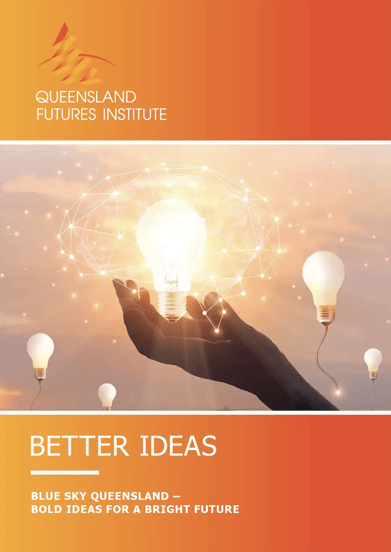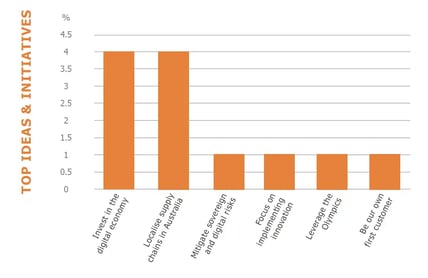| The key theme from the 2022 Queensland Futures Institute’s Forum on Blue Sky QLD – Bold Ideas for a Bright Future was the need for implementation of innovative ideas across industries in order to achieve the best commercial, economic and social outcomes over the coming years. The discussion also highlighted the growing challenges and roadblocks to innovation, such as workforce and talent shortages, insecure global supply chains and climate change risks. There is a significant opportunity for Queensland, particularly in the lead up to the 2032 Olympics, to develop capabilities across industry and benefit the local economy, regions and communities. |
 |
QFI thanks its sponsors |
|

|

|
Platinum Sponsor |
Silver Sponsor |
Summary from Speaker
 |
Dr Stefan Hajkowicz, Principal Scientist in Strategy and Foresight, Data 61, CSIRO
- In July, CSIRO released its Global Megatrends report, which provides an evidence-based approach about how the world will change over the coming 10 to 20 years. This has changed significantly since the last publication of the report in 2012.
- The first of the megatrends is the need to adapt to climate change. In ten years, this has shifted from debating whether or not it exists to being the lived experience of many people. This involves emissions reductions and climate change adaptation, which we are under prepared for given the impacts are being felt sooner and more intensely than expected.
- Data at the meteorological monitoring station in Cape Grim, Tasmania shows a consistent increase in carbon dioxide in the atmosphere since 1980, and this is the fundamental driver of extreme weather events. An example of which has seen Wivenhoe Dam filling from 30 to 40% to 160% of its capacity in five days.
- Another example of this is extreme heat, which has significant impacts on human health and wellbeing, and kills more than all other categories of natural hazard put together.
- This is also related to the prevalence of severe droughts and the ability of our water supply system to cope with this. This has further implications for land use planning.
- The second megatrend is being leaner, cleaner and greener around resource constraints across food, water and mineral energy resources. Given increased resource consumption and population across the Asia Pacific region, it is critical to focus on the demand and supply of food, electricity and minerals.
- Notably, Queensland has made an important first step in the transition, having launched the $62 billion, energy plan. But this will require consideration of a number of challenges such as minerals and rare element production required to meet the increasing demand we will see in the future.
- The expanding healthcare sector is another megatrend, which is seeing rapidly increasing government spending. This must shift before this budget constraint restricts obtaining the best healthcare outcomes for Australians and requires preventative health interventions.
- Geopolitical shifts are another megatrend which is playing out in several ways, such as increased military spending, which is reaching levels seen around World War II. This is also relevant for fertilisers and pharmaceuticals, which are largely produced overseas. There is also a large importance on sovereign capability and securing supply chains in this area to mitigate geopolitical risks.
- Diving into digital is another megatrend and was accelerated over Covid across multiple industries such as online retail, education and health, in addition to the remote working undertaken by businesses. This is changing mobility trends and has implications for physical and digital infrastructure planning.
- Technology and artificial intelligence are the next megatrend, which is also playing out across multiple areas, including in science, technology, the arts and humanities.
- The last of the megatrends is the human dimension, signifying the trust and information available in the world today. This includes thinking about privacy and confidentiality issues, data ethics, security and governance.
|
Comments from Panel
Question 1 – Let’s think about the blue-sky big picture. Where could industry be if we were unshackled?
 |
Prof. Josephine Forbes
-
Mater Research brings a unique view of innovation and presents opportunities in therapeutics in both development and translation into the clinic. There are many challenges along that in this area, some of which have played out through the Covid pandemic, over which time development and implementation has needed to accelerate quickly, proving the way for these developments to be translated to the clinic much quicker.
-
Onshore manufacturing capabilities are a priority in this area to mitigate the risk of medication shortages when dependent on global supply chains. There have recently been a number of medications or ingredients which have been in shortage globally and restricted access by Australians over recent years. Itis critical to secure these supply chains via local manufacturing moving forward.
-
Preventative healthcare must also become a focus in the future to further mitigate the risks associatedwith restricted supply chains and increasing costs – and the impacts this has on health outcomes forAustralia. Developing measures to prevent diseases are equally important as medicines to treat them.
|
 |
Prof. Bernadette McCabe
-
The Centre for Agricultural Engineering at the University of Southern Queensland has been running for 30 years, applying practical solutions on the farm with an engineering perspective. There are many focus areas, including irrigation, water management, automation, robotics, machine vision, precision agriculture, and energy, particularly bioenergy and bio resource utilisation.
-
There is great opportunity in the sector in future fuels and fertilizer for farmers. Recent conditions aroundthe global energy crisis and fertiliser production impacts caused by geopolitical events have highlightedthese two critical inputs – energy and fertiliser – as an increasing challenge as farmers face rising costs.In addition to recent flooding, the conditions faced by farmers are extremely challenging.
-
Hydrogen represents a massive opportunity to address both the challenge of energy and fertiliser. The potential domestic market for hydrogen is sizeable compared to export markets, and the agriculture sector would be able to support manufacturing, industrialising and regionalising of hydrogen production. If this was also supported by onshore production of solar panels, it would represent a full supply chain fromPV panel, hydrogen, ammonia and fertiliser production, building resilient and economically dependent regions. However, this must be supported by policy to occur.
|
 |
Carl Solder
-
Australia used to lead globally in its adoption of technology but is now slipping behind. There is massive opportunity for Australia to become a leading digital economy and digital country, taking advantage of technology and innovation.
-
This requires investment in connectivity and digital infrastructure. Governments must continue to drive this investment and provide connectivity – terrestrial, fibre, 5G or radio – to enable digital growth.
-
We must also continue to drive the necessary security around data to ensure people’s safety. Additionally, this must be done in a way to ensure Australia becomes a leading digital economy.
|
 |
Wayne Gerard
-
Queensland’s competitive advantage is its human capital. Government and investment must unlock and facilitate this, empowering communities to drive positive change. This spans renewable energy, mining of rare earth minerals, and climate change.
-
This also requires Queenslanders to become our first customers. Developing a market in which to build momentum and bring forth innovative ideas and solutions. To do this, we must build our sovereign capability, maximise talent and collaboration. This will be addressed through investing in connectivity.
|
 |
Derek Merdith
-
QCN is a wholesaler of telecommunications infrastructure, with a telecommunications fibre network spanning 13,000km and 20,000 towards for hosting wireless telecommunications across Queensland and delivering carrier grade services of 400Gbps. QCN is owned by the Queensland Government via its parent entities Energy Queensland and Powerlink.
-
QCN’s mandate is to break the digital divide, facilitating services enjoyed in metropolitan areas across the whole of Queensland, at affordable prices.
-
This will unlock limitless innovation in technology, such as high-definition video, Artificial Intelligence and drone technology. As an example, drones and AI have reduced the use of herbicides by 95% at InFarm, Goondiwindi by targeting just the weed affected areas rather than entire paddocks. Similar technology can be used in maintenance checks for physical infrastructure, or in lifesaving and shark spotting.
-
This AI and the required data are a massive challenge, requiring strong data networks and telecommunications infrastructure across the state. This must be built to ensure the regions have access to the wide benefits of these technologies.
|
Question 2 – How will the Olympics provide opportunities across industries?
 |
Wayne Gerard
-
It is critical to consider the state’s legacy in preparation of hosting the 2032 Olympics in Brisbane. Every business and community organisation, including schools, have an opportunity to contribute to this, and create economic and social benefits.
-
There are also opportunities around climate change and technology in the lead up to 2032. Most organisations leverage less than 20% of the functionality of technologies that are already owned, and less than 5% of the data currently produced. This must be unlocked and leveraged in the lead up to the Olympics.
-
Being transparent around decisions and the climate impact of the Olympics will also be important, exemplifying Queensland’s green credentials in delivering a climate positive Olympics.
|
 |
Prof. Josephine Forbes
-
Community participation is an important channel to drive health and community outcomes around the Olympics.
-
At the London Olympics, there were plans to increase community participation in sport and exercise elevated, however this was shown to have not occurred. A similar trend of falling short of this goal was likely seen at the Sydney and Rio Olympics. But Brisbane has an opportunity to plan for and meet this target.
-
To do this will require involvement from both grassroots and schools. Targeting young people is the best way to enact behavioural change and drive this legacy, and this must be supported by government.
-
Addressing broader health issues will also require innovation to drive the required economic and policy changes needed to deliver improved health outcomes. In this sense, leveraging the Olympics will utilise abroad segment of Queenslanders as well as providing cost efficiencies associated with such a large event.
-
Doing this successfully will support preventative health, which is already known to have favourable cost benefit ratio to implement but nonetheless faces challenges due to the required behavioural changes.
|
 |
Derek Merdith
- The 2032 Olympics will see eSports take off, requiring strong digital infrastructure to make this happen. If Queensland invests in this infrastructure, it will improve connectivity and speeds not only in metropolitan areas but also across the state.
|
Question 3 – Will Australia be a maker or a taker of digital technology?
 |
Carl Solder
-
While everyone is a consumer of digital technology, there is opportunity to also be a maker of it. However, due to the scale of this challenge, this will require collaboration across the global community. We cannot rely on other countries for technology innovation; we must build out Australian industry to encourage innovation and to develop solutions to the world’s problems. This includes transport, health, data and trust, mining and education, and requires collaboration and partnerships across industry, research, education and training to deliver.
-
There is a critical need to address the skills shortage needed to build the digital economy and accelerate this change.
|
 |
Wayne Gerard
-
There is need to innovate in order to solve societal and economic problems. Queensland needs to be the builders, not the buyers – and to be the builders, we need to have the customers, which requires planning around the human capital and collaboration required. There will be a major role for local innovators, entrepreneurs and researchers to help industry transform around this and create solutions to their own problems, rather than outsourcing this. This will build capability and the economy.
-
Doing this will also see organisations diversify, moving from being focused on a single dimension –profit – to also understanding ESG responsibilities, building our economy, creating jobs and developing a sustainable sovereign supply chain. This requires strong business and policy leadership to achieve.
-
In thinking about the role of research in this journey, Queensland does not have a problem with research; the research and education sector is world-class and has incredible talent. However, there is a development bottleneck due to the challenges around commercialisation of the solutions that solve problems relevant to our economy.
|
Question 4 – What are the impacts to agriculture if geopolitical risks adversely impact Australia’s global trade?
 |
Prof. Bernadette McCabe
-
The agriculture industry is heavily dependent on global trade. Given geopolitical and sovereign risk, there is a need to secure supply chains and ensure energy, nutrient and food security. This requires sovereign manufacturing capability to be developed by Australian industry.
-
The research in the agriculture industry is strong but requires broader development to deliver the innovation and outcomes needed in the future. Farms present massive opportunity to test and develop new expertise coming from research. There are a number of innovative developments such as bioenergy and biogas, and other emissions reduction technologies which are best implemented and used in the farm setting.
-
Policy has a role to play in facilitating this innovation and industry development. One of the biggest issues for farmers is the education and assistance in emissions reduction, energy and fuel efficiency. Therefore, initiatives such as the emissions reduction fund help to drive change and deliver improved outcomes while being economically and commercially viable, helping farmers be cost effective and develop sovereign capability moving forward.
-
This is becoming increasingly important as farmers face the physical impacts of climate change, experiencing floods and drought which impact crop and livestock production. Climate change adaptation is therefore critical for agriculture to become more resilient to these risks. There is also opportunity to innovate in this space, such as through drought proofing and collaboration between farmers through drought hubs.
|
Question 5 – The healthcare sector has been hit hard over the pandemic. What is most critical to do without adding to the exhaustion experienced by workers?
 |
Prof. Josephine Forbes
-
One of the biggest issues in innovation and research development in healthcare is the resourcing of clinical staff to facilitate this. There is a workforce issue which must therefore be addressed, given research is leading developments in healthcare. While research and policy can outline solutions to improve healthcare outcomes, this is useless without the ability to translate this in clinics.
|
Question 6 – Given recent data breaches, and global legislation around the collection, use and storage of data, what is most important for Australia to do in data privacy and protection?
 |
Carl Solder
-
The size and impact of technology and data vulnerabilities will continue to increase as these become more prevalent in society. It is important to consider security across the four dimensions of user, device, network and application, and design around the human interface at each of these points. Security against active threats in all of these dimensions would effectively mitigate this risk.
-
Cisco has invested heavily developing the largest commercial threat intelligence organisation, scanning over 10 billion artifacts a day to identify new threats, malware or viruses, but services such as this must be incentivised by governments to be used across different businesses.
|
Question 7 – What is most important around the cybersecurity risks we face?
 |
Wayne Gerard
|
Question 8 – What policy reform or initiative from the government would assist your industry to advance your ideas for a Brighter Future?
 |
Derek Merdith
-
There is currently a gap in people’s understanding around the digital economy, thinking about either digital devices and applications, or digital infrastructure. Moving forward, it is critical to develop both and receive support from government to continue the development of high-quality infrastructure; we cannot assume this will automatically be built out as demand increases. This requires a specific focus from state government departments to highlight how digital infrastructure is equally important as other physical infrastructure such as roads.
|
Audience Questions
Question 1 – How well equipped is Queensland to take advantage of the innovation in the Pacific and have a greater impact for our region?
| 
|
Prof. Bernadette McCabe
-
Fuels and the fertilizer have yet to be significantly developed and innovated on. Development of this critical agricultural inputs should be pegged to the development of hydrogen, seeing growth in all of these areas. We must also ensure implementation is a focus for industry development and that we have the ability in Queensland to do so.
-
There are also benefits from ingraining innovation and development in the culture of industry and the regions to support this growth. For example, biogas is heavily ingrained in the societal norms in Sweden, with the technology being mainstream. The same level of normalcy should be achieved with hydrogen in the future.
-
Policy must play a role in making these developments more accessible. The Emissions Reduction Fund has been a great example of a policy doing this. This allows increased deployment of these new technology and de-risk their implementation for farmers, as well as linking this to new income streams.
|
Question 2 – How can ESG best be addressed across industries to unlock, facilitate and drive broader industry and economic development?
| 
|
Carl Solder
- Unlocking ESG is core to technology development at Cisco, given the synergies this provides through digitisation. Sustainability can further be unlocked given the various technologies which can help to improve efficiencies and reduce emissions across industries. This requires adequate connectivity and network infrastructure to achieve.
|
Question 3 – How can we best benefit from the increase in data and telecommunication services available to Australians?
| 
|
Carl Solder
-
The constant improvement of connectivity and speeds is critical to the growth of the telecommunications industry. New wireless technologies and increasing bandwidths mean an increased ability to sustain higher loads and support industries to leverage technology and data.
-
However, this will also give rise to the need to filter data and reduce noise as we are exposed to increasing amounts of information. Technology such as AI will play a role in performing this function.
|
| Summary of Comments 
|
- There is a clear need to support the digital economy in terms of both leveraging technology to improve outcomes across industries and communities, and by investing in digital infrastructure to ensure connectivity for the regions and enable the broader use of data and technologies. As this becomes more pervasive, there is also a need to ensure security of digital assets and data.
- The recent geopolitical shocks have also highlighted the need to secure supply chains. Onshoring areas such as manufacturing, heavy industry and healthcare would increase resilience and mitigate sovereign risk but also create opportunity to add value within the Queensland economy, strengthening both domestic and export markets.
- These opportunities must be taken advantage of in the lead up to the 2032 Olympics to maximise the benefits ofinnovation across the economy, industry and communities.
|


























